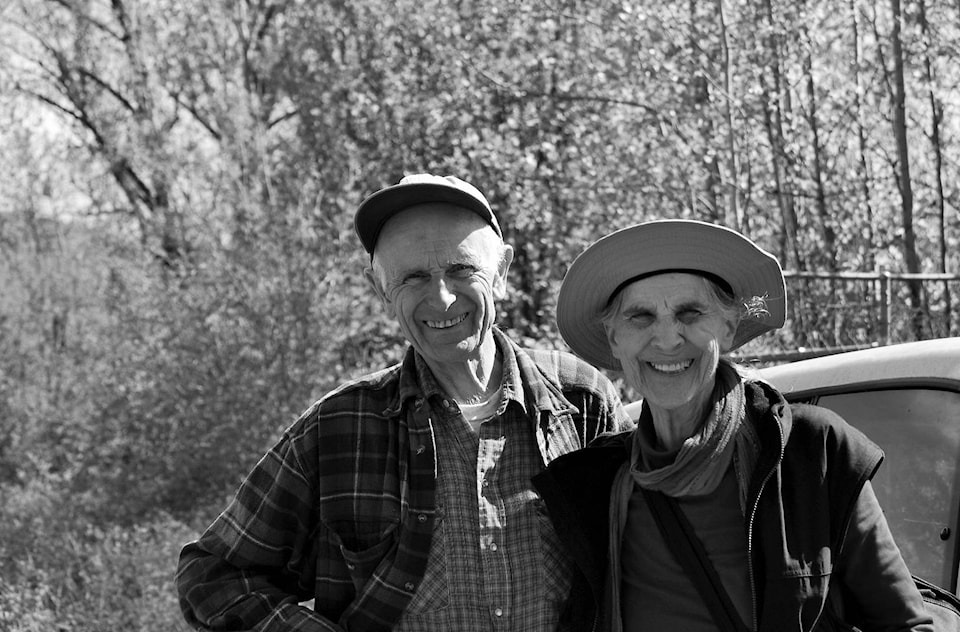Recently I received a present from a dear friend. Rita Bos sent me a lovely booklet she had produced on the Vernon Heronry. It complemented Rita’s handcrafted Christmas card, which I always look forward to with great anticipation.
The booklet contains fifty-two pages of wonderful photographs of the great blue herons, which have adopted a sizeable cluster of cottonwoods as a seasonal home, where they nest, mate, and raise their chicks. What is unique about the setting is that it is part of a larger industrial lot, which Rita’s life partner Jan had purchased in 1986. He relocated his car storage business to the property when he had to move from his former location along Vernon Creek to accommodate highway reconstruction.
When he started moving to the new location, several pairs of adult herons showed up as well, occupying a small cluster of nests previously there. Jan thought three pairs had followed him to the new site from his former property. He was not sure what the birds would do after he completed his relocation; however as they accepted his presence and continued to return, Jan decided he was going to share the land with his avian precursors. In the years that followed, heron numbers continued to increase so that by 1997 the seasonal colony consisted of about forty nests. By 2016 Jan documented over 70 nests and the presence of seventy-five adults and about two hundred chicks. By this time, the phenomenon had received wide publicity due to the uniqueness of the site and the herons’ tolerance of nearby human activity.
Herons are normally shy birds that prefer their solitude. Notable exceptions exist in some urban settings, as in Vancouver’s Stanley Park. What is different about the Vernon colony is that they occupy it only for the breeding season. Herons typically start arriving every year in late February, and by April chicks are hatching after a four-week incubation period. This is when they are the most vulnerable to predation by bald eagles and hawks. Storms can also wreak havoc: on April 23, 2017 twenty-nine chicks and one adult perished in a windstorm. The birds start leaving the heronry in late July, and by late August all are gone.
The couple’s dedication to the preservation of the majestic birds in that unique location has been documented in various media, including the local paper, radio, television, and the Beautiful British Columbia magazine. Jan, an elementary school teacher for twenty-six years, continued his connection with the young by offering tours of the bird sanctuary, and holding Show & Tell sessions at various schools. Other guests arrived in droves to observe and photograph the stately birds.
The struggle did not come without its costs. To protect the bird sanctuary Jan signed a covenant with the Greater Vernon Parks and Recreation District in 1992; it protected the two-hectare sanctuary from development in exchange for a small property tax concession. Developers, however, moved in and subdivided adjacent properties for residential use. When a windstorm brought a cottonwood into one of the new lots, damaging a building, Jan was facing a lawsuit from the insurance company. The case dragged out, and when it was settled, Jan was some $20,000 poorer. It could have been a lot worse if it were not for the support he received from an admiring public.
My personal connection with Jan and Rita developed from the construction of a ski shelter at Bonanza Pass that we named after Rita’s brother, Gordon Keir. The couple usually joined our September work parties, and on one occasion even brought their 86 year-old father David along. Our association was the subject of a previous newspaper article (“Bonanza Pass Connections”, January 19, 2017).
Sadly, David and Jan are no longer with us. David passed away at age 100 on October 12, 2013. Jan did not awaken from his sleep on the morning of March 3, 2017, leaving Rita to cope with the emptiness and the numerous problems that followed. The heron booklet is dedicated to Jan’s memory, and all proceeds from its sale will go to the Vernon Heronry Protection Society.
Just before Jan passed away Rita was starting to worry that the herons were late in returning, and something had gone wrong. Jan had no doubts, however, and he assured her that they would come. And so they did. The first birds showed up on March 5, two days after their benefactor had left them, leaving the birding community in distress. Jan’s dedication to the majestic birds, however, will continue to bear fruit. I am certain about that.
